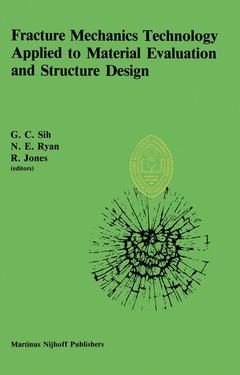Fracture Mechanics Technology Applied to Material Evaluation and Structure Design, Softcover reprint of the original 1st ed. 1983 Proceedings of an International Conference on ‘Fracture Mechanics Technology Applied to Material Evaluation and Structure Design’, held at the University of Melbourne, Melbourne, Australia, August 10–13, 1982
Langue : Anglais
Coordonnateurs : Sih George C., Ryan N., Jones R.

The International Conference on Fracture Mechanics Technology Applied to Material Evaluation and Structure Design was held in Melbourne, Australia, from August 10 to 13, 1982. It was sponsored jointly by the Australian Fracture Group and Institute of Fracture and Solid Mechanics at Lehigh University. Pro fessor G. C. Sih of Lehigh University, Drs. N. E. Ryan and R. Jones of Aeronau tical Research Laboratories served as Co-Chairmen. They initiated the organiza tion of this international event to provide an opportunity for the practitioners, engineers and interested individuals to present and discuss recent advances in the evaluation of material and structure damage originating from defects or cracks. Particular emphases were placed on applying the fracture mechanics tech nology for assessing interactions between material properties, design and opera tional requirements. It is timely to hold such a Conference in Australia as she embarks on technology extensive industries where safeguarding structures from pre mature and unexpected failure is essential from both the technical and economical points. view The application of system-type approach to failure control owes much of its success to fracture mechanics. It is now generally accepted that the discipline, when properly implemented, provides a sound engineering basis for accounting in teractions between material properties, design, fabrication, inspection and op erational requirements. The approach offers effective solutions for design and maintenance of large-scale energy generation plants, mining machineries, oil ex ploration and retrieval equipments, land, sea and air transport vehicles.
General Lectures.- Mechanics of subcritical crack growth.- Damage tolerance through the control of microstructure.- A review of elasto-plastic fracture design methods and suggestions for a related hierarchy of procedures to suit various structural uses.- The fatigue strength of welded tubular steel offshore structures.- Recent studies on brittle crack propagation and arrest in Japan.- Technical Sessions.- Section I Microstructure.- Relationships between microstructure and fracture toughness.- The influences of dual phase microstructures on crack propagation by mean stress.- A new method for observing fatigue microcrack propagation.- An experimental study on the fracture behavior of laminated steel composites.- Influence of microstructures on crack propagation in stainless steel weld metal.- Section II Stress and Failure Analysis.- Numerical analysis for notches of arbitrary notch angle.- Prediction of failure sites ahead of moving energy source.- Tension and bending of a semi-elliptical surface crack.- Stress intensity factors for externally and internally cracked pressurized thick cylinders with residual and thermal stresses.- Influence of crack closure on the stress intensity factor for cylindrical shells subjected to bending.- Analysis of a singular solution in three dimensional surface crack problem.- Section III Fracture and Material Testing.- Basic tensile properties of a low-alloy steel BS4360-50D.- Fracture toughness acceptance testing of aluminum alloys for aircraft applications.- Relation between cracks and electron beam welding condition of SUS304L stainless sintered steel.- Fracture toughness of A533 B steel: electrical potential method.- Section IV Analytical and Experimental Modelling.- Modelling of crack growth resistance curves.- Finite element analysisof non-self-similar crack growth process.- Energy-release rates in dynamic fracture: path-invariant integrals, and some computational studies.- Modelling of sub-critical flaw growth in three dimensional crack problems.- Material selection and structural design for safety and durability.- Section V Mixed Mode Fracture.- Study of the fracture behaviour of slab mill rolls.- The application of mixed mode II/III fracture mechanics analysis to the cracking of rails.- On mixed mode ductile fracture criteria — a note about the core region.- Further observations on mixed mode plane stress ductile fracture.- Section VI Fatigue Crack Growth.- Fatigue crack growth in autofrettaged thick-walled cylinders.- Use of damage concept on predicting fatigue life in two-level strain controlled tests.- Fatigue behaviour of steel rectangular hollow sections used in bus structures.- Fatigue crack growth in welded steel rectangular hollow sections.- An effect of specimen size on fatigue crack growth and plastic zone size.- Crack closure and overload effects in fatigue.- The influence of cyclic impact loading and stress ratio on fatigue crack growth rate in aluminum alloy.- The effect of contact stress intensity factors on fatigue crack propagation.- Design of weld attachments to boiler tubes under fatigue loadings.- Section VII Environmental Effects.- Criterion for fracture of plain concrete.- Thermal embrittlement and purity in MAR350 steel.- Environmental effect on fatigue fracture in high impact polystyrene.- Use of thermometric method of analysis for evaluation of colloids for 70/30 brass in nitric acid.- Auger analysis of the high temperature embrittlement of an Alpha brass.- Fatigue in lubricants environment.- Application of auger electron spectroscopy to surface analysis of fracturesproduced by hydrogen embrittlement.- Section VIII Composites and Nonmetals.- Repair of ballistically impacted carbon fibre reinforced (CFR) laminates.- Fatigue damage in glass reinforced plastics.- Damage tolerance of fibre composite laminates.- Probabilistic aspects of mechanical damage in concrete structures.- List of Participants.
Date de parution : 06-2012
Ouvrage de 671 p.
15.5x23.5 cm
Mots-clés :
alloy; composite; fatigue; fracture mechanics; glass; modeling; spectroscopy
© 2024 LAVOISIER S.A.S.



